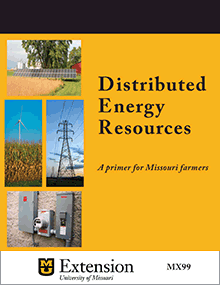 Major changes are occurring in how electricity is generated, distributed and used. These changes impact Missouri. This publication is designed to explain this transition from centralized energy generation towards distributed energy generation and the potential impacts it will have for rural landowners.
Major changes are occurring in how electricity is generated, distributed and used. These changes impact Missouri. This publication is designed to explain this transition from centralized energy generation towards distributed energy generation and the potential impacts it will have for rural landowners.
Wind and solar generation continue to grow in the U.S. and Missouri for three reasons:
- The declining lifetime costs of wind and photovoltaic solar.
- Economic incentives for renewable energy investment and generation.
- Increased costs for energy companies to maintain coal-fired electricity generation.
Growth in renewable energy contributes to two scenarios in rural Missouri. First, rural landowners may receive proposals from utility-scale wind and solar energy developers to lease land. Second, consumers may receive offers and incentives to install on-farm solar panels, generators, batteries and other behind-the-meter electrical systems. This publication summarizes trends, explains the players and policies involved and guides landowners to information helpful in understanding renewable energy opportunities.
Topics
- Centralized and distributed electricity generation
- Centralized generation and distributed electricity resources
- Electricity generation in Missouri
- Changes in electricity generation in Missouri
- The power grid and components of electricity costs
- Interconnections, regional transmission organizations (RTOs) and independent system operators (ISOs)
- Electricity cost components
- Definitions of key terms
- Distributed energy resource (DER) technologies
- Photovoltaic (PV) solar
- Wind
- Combined heat and power (CHP)
- Other DERs
- Future implications of distributed energy resources (DERs)
- DERs and grid management
- Opportunities from DERs for Missouri farmers and landowners
- Land leases
- Behind-the-meter generation
- DERs and farm risk management
Pages
- 31